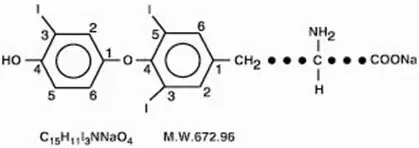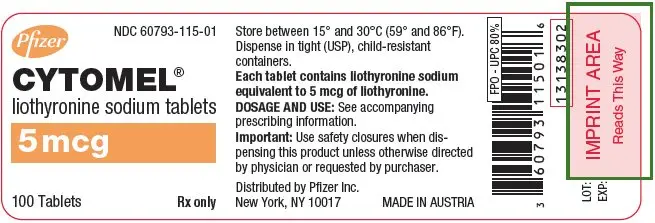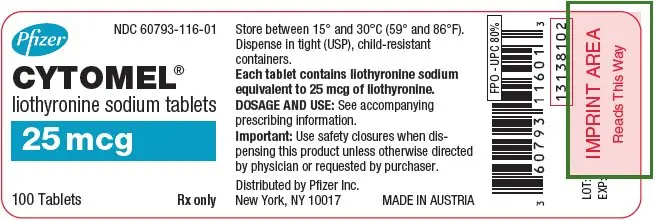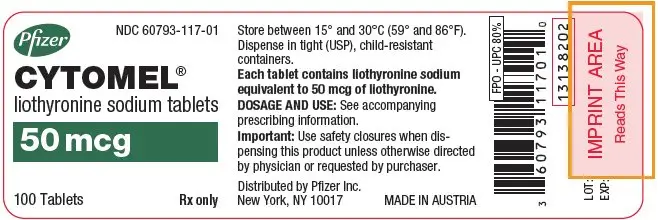Drug Detail:Cytomel (Liothyronine [ lye-oh-thye-roe-neen ])
Drug Class: Thyroid drugs
Highlights of Prescribing Information
CYTOMEL® (liothyronine sodium) tablets, for oral use
Initial U.S. Approval: 1956
WARNING: NOT FOR TREATMENT OF OBESITY OR FOR WEIGHT LOSS
See full prescribing information for complete boxed warning.
- Thyroid hormones, including CYTOMEL, should not be used for the treatment of obesity or for weight loss.
- Doses beyond the range of daily hormonal requirements may produce serious or even life-threatening manifestations of toxicity (6, 7.7, 10).
Recent Major Changes
| Indications and Usage (1.1, 1.2, 1.3) | 12/2018 |
| Dosage and Administration (2.1, 2.2, 2.3, 2.4, 2.5, 2.6) | 12/2018 |
| Contraindications (4) | 12/2018 |
| Warnings and Precautions (5.1, 5.2, 5.3, 5.4, 5.5, 5.6) | 12/2018 |
Indications and Usage for Cytomel
CYTOMEL is an L-triiodothyronine (T3) indicated for:
- Hypothyroidism: As replacement in primary (thyroidal), secondary (pituitary), and tertiary (hypothalamic) congenital or acquired hypothyroidism (1.1)
- Pituitary Thyroid-Stimulating Hormone (TSH) Suppression: As an adjunct to surgery and radioiodine therapy in the management of well-differentiated thyroid cancer (1.2)
- Thyroid Suppression Test: As a diagnostic agent in suppression tests to differentiate suspected mild hyperthyroidism or thyroid gland autonomy (1.3)
Limitations of Use:
- -
- Not indicated for suppression of benign thyroid nodules and nontoxic diffuse goiter in iodine-sufficient patients. (1)
- -
- Not indicated for treatment of hypothyroidism during the recovery phase of subacute thyroiditis. (1)
Cytomel Dosage and Administration
- Administer CYTOMEL orally once daily and individual dosage according to patient response and laboratory findings (2.1)
- See full prescribing information for recommended dosage for hypothyroidism (2.2) TSH suppression in well-differentiated thyroid cancer (2.3) and for thyroid suppression test (2.4)
- When switching a patient to CYTOMEL, discontinue levothyroxine therapy and initiate CYTOMEL at a low dosage. Gradually increase the dose according to the patient's response (2.5)
- Adequacy of therapy determined with periodic monitoring of TSH and T3 levels as well as clinical status (2.6)
Dosage Forms and Strengths
Tablets: 5 mcg, 25 mcg, 50 mcg (3)
Contraindications
Uncorrected adrenal cortical insufficiency (4)
Warnings and Precautions
- Cardiac adverse reactions in the elderly and in patients with underlying cardiovascular disease: Initiate CYTOMEL at less than the full replacement dose because of the increased risk of cardiac adverse reactions, including atrial fibrillation (2.3, 5.1, 8.5)
- Myxedema coma: Do not use oral thyroid hormone drug products to treat myxedema coma. (5.2)
- Acute adrenal crisis in patients with concomitant adrenal insufficiency: Treat with replacement glucocorticoids prior to initiation of CYTOMEL treatment (5.3)
- Prevention of hyperthyroidism or incomplete treatment of hypothyroidism: Proper dose titration and careful monitoring is critical to prevent the persistence of hypothyroidism or the development of hyperthyroidism. (5.4)
- Worsening of diabetic control: Therapy in patients with diabetes mellitus may worsen glycemic control and result in increased antidiabetic agent or insulin requirements. Carefully monitor glycemic control after starting, changing, or discontinuing thyroid hormone therapy (5.5)
- Decreased bone mineral density associated with thyroid hormone over-replacement: Over-replacement can increase bone resorption and decrease bone mineral density. Give the lowest effective dose (5.6)
Adverse Reactions/Side Effects
Most common adverse reactions for CYTOMEL are primarily those of hyperthyroidism due to therapeutic overdosage: arrhythmias, myocardial infarction, dyspnea, headache, nervousness, irritability, insomnia, tremors, muscle weakness, increased appetite, weight loss, diarrhea, heat intolerance, menstrual irregularities, and skin rash (6)
To report SUSPECTED ADVERSE REACTIONS, contact Pfizer, Inc. at 1-800-438-1985 or FDA at 1-800-FDA-1088 or www.fda.gov/medwatch.
Drug Interactions
See full prescribing information for drugs that affect thyroid hormone pharmacokinetics and metabolism (e.g., absorption, synthesis, secretion, catabolism, protein binding, and target tissue response) and may alter the therapeutic response to CYTOMEL (7)
Use In Specific Populations
Pregnancy may require the use of higher doses of thyroid hormone (2.2, 8.1)
See 17 for PATIENT COUNSELING INFORMATION.
Revised: 7/2019
Related/similar drugs
levothyroxine, Synthroid, Euthyrox, liothyronine, Armour Thyroid, Levoxyl, TirosintFull Prescribing Information
WARNING: NOT FOR TREATMENT OF OBESITY OR FOR WEIGHT LOSS
- Thyroid hormones, including CYTOMEL, either alone or with other therapeutic agents, should not be used for the treatment of obesity or for weight loss.
- In euthyroid patients, doses within the range of daily hormonal requirements are ineffective for weight reduction.
- Larger doses may produce serious or even life-threatening manifestations of toxicity, particularly when given in association with sympathomimetic amines such as those used for their anorectic effects [see Adverse Reactions (6), Drug Interactions (7.7), and Overdosage (10)].
1. Indications and Usage for Cytomel
1.1 Hypothyroidism
CYTOMEL is indicated as a replacement therapy in primary (thyroidal), secondary (pituitary), and tertiary (hypothalamic) congenital or acquired hypothyroidism.
1.2 Pituitary Thyroid-Stimulating Hormone(TSH) Suppression
CYTOMEL is indicated as an adjunct to surgery and radioiodine therapy in the management of well-differentiated thyroid cancer.
2. Cytomel Dosage and Administration
2.1 General Principles of Dosing
The dose of CYTOMEL for hypothyroidism or pituitary TSH suppression depends on a variety of factors including: the patient's age, body weight, cardiovascular status, concomitant medical conditions (including pregnancy), concomitant medications, co-administered food and the specific nature of the condition being treated [see Dosage and Administration (2.2, 2.3, 2.4), Warnings and Precautions (5), and Drug Interactions (7)]. Dosing must be individualized to account for these factors and dose adjustments made based on periodic assessment of the patient's clinical response and laboratory parameters [see Dosage and Administration (2.4)].
Administer CYTOMEL tablets orally once daily.
2.2 Recommended Dosage for Hypothyroidism
2.3 Recommended Dosage for TSH Suppression in Well-Differentiated Thyroid Cancer
The dose of CYTOMEL should target TSH levels within the desired therapeutic range. This may require higher doses, depending on the target level for TSH suppression.
2.4 Recommended Dosage for Thyroid Suppression Test
The recommended dose is 75 mcg to 100 mcg daily for 7 days, with radioactive iodine uptake being determined before and after the 7 day administration of CYTOMEL. If thyroid function is normal, the radioiodine uptake will drop significantly after treatment. A 50% or greater suppression of uptake indicates a normal thyroid-pituitary axis.
2.5 Switching from Levothyroxine to CYTOMEL
CYTOMEL has a rapid onset of action and residual effects of the other thyroid preparation may persist for the first several weeks after initiating CYTOMEL therapy. When switching a patient to CYTOMEL, discontinue levothyroxine therapy and initiate CYTOMEL at a low dosage. Gradually increase the CYTOMEL dose according to the patient's response.
2.6 Monitoring TSH and Triiodothyronine (T3) Levels
Assess the adequacy of therapy by periodic assessment of laboratory tests and clinical evaluation. Persistent clinical and laboratory evidence of hypothyroidism despite an apparent adequate replacement dose of CYTOMEL may be evidence of inadequate absorption, poor compliance, drug interactions, or a combination of these factors.
3. Dosage Forms and Strengths
Tablets (round, white to off-white) available as follows:
- 5 mcg: debossed with KPI on one side and 115 on the other side
- 25 mcg: scored on one side and debossed with KPI and 116 on the other side
- 50 mcg: scored on one side and debossed with KPI and 117 on the other side
4. Contraindications
CYTOMEL is contraindicated in patients with uncorrected adrenal insufficiency [see Warnings and Precautions (5.3)].
5. Warnings and Precautions
5.1 Cardiac Adverse Reactions in the Elderly and in Patients with Underlying Cardiovascular Disease
Overtreatment with thyroid hormone may cause an increase in heart rate, cardiac wall thickness, and cardiac contractility and may precipitate angina or arrhythmias, particularly in patients with cardiovascular disease and in elderly patients. Initiate CYTOMEL therapy in this population at lower doses than those recommended in younger individuals or in patients without cardiac disease [see Dosage and Administration (2.3) and Use in Specific Populations (8.5)].
Monitor for cardiac arrhythmias during surgical procedures in patients with coronary artery disease receiving suppressive CYTOMEL therapy. Monitor patients receiving concomitant CYTOMEL and sympathomimetic agents for signs and symptoms of coronary insufficiency. If cardiovascular symptoms develop or worsen, reduce or withhold the CYTOMEL dose for one week and restart at a lower dose.
5.2 Myxedema Coma
Myxedema coma is a life-threatening emergency characterized by poor circulation and hypometabolism, and may result in unpredictable absorption of thyroid hormone from the gastrointestinal tract. Use of oral thyroid hormone drug products is not recommended to treat myxedema coma. Administer thyroid hormone products formulated for intravenous administration to treat myxedema coma.
5.3 Acute Adrenal Crisis in Patients with Concomitant Adrenal Insufficiency
Thyroid hormone increases metabolic clearance of glucocorticoids. Initiation of thyroid hormone therapy prior to initiating glucocorticoid therapy may precipitate an acute adrenal crisis in patients with adrenal insufficiency. Treat patients with adrenal insufficiency with replacement glucocorticoids prior to initiating treatment with CYTOMEL [see Contraindications (4)].
5.4 Prevention of Hyperthyroidism or Incomplete Treatment of Hypothyroidism
CYTOMEL has a narrow therapeutic index. Over- or undertreatment with CYTOMEL may have negative effects on growth and development, cardiovascular function, bone metabolism, reproductive function, cognitive function, emotional state, gastrointestinal function, and on glucose and lipid metabolism. Titrate the dose of CYTOMEL carefully and monitor response to titration to avoid these effects [see Dosage and Administration (2.4)]. Monitor for the presence of drug or food interactions when using CYTOMEL and adjust the dose as necessary [see Drug Interactions (7) and Clinical Pharmacology (12.3)].
5.5 Worsening of Diabetic Control
Addition of thyroid hormone therapy in patients with diabetes mellitus may worsen glycemic control and result in increased antidiabetic agent or insulin requirements. Carefully monitor glycemic control after starting, changing, or discontinuing CYTOMEL [see Drug Interactions (7.2)].
5.6 Decreased Bone Mineral Density Associated with Thyroid Hormone Over-Replacement
Increased bone resorption and decreased bone mineral density may occur as a result of thyroid hormone over-replacement, particularly in post-menopausal women. The increased bone resorption may be associated with increased serum levels and urinary excretion of calcium and phosphorous, elevations in bone alkaline phosphatase, and suppressed serum parathyroid hormone levels. Administer the minimum dose of CYTOMEL that achieves the desired clinical and biochemical response to mitigate against this risk.
6. Adverse Reactions/Side Effects
Adverse reactions associated with CYTOMEL therapy are primarily those of hyperthyroidism due to therapeutic overdosage [see Warnings and Precautions (5.4) and Overdosage (10)]. They include the following:
General: fatigue, increased appetite, weight loss, heat intolerance, fever, excessive sweating
Central nervous system: headache, hyperactivity, nervousness, anxiety, irritability, emotional lability, insomnia
Musculoskeletal: tremors, muscle weakness and cramps
Cardiovascular: palpitations, tachycardia, arrhythmias, increased pulse and blood pressure, heart failure, angina, myocardial infarction, cardiac arrest
Respiratory: dyspnea
Gastrointestinal: diarrhea, vomiting, abdominal cramps, elevations in liver function tests
Dermatologic: hair loss, flushing
Endocrine: decreased bone mineral density
Reproductive: menstrual irregularities, impaired fertility
7. Drug Interactions
7.1 Drugs Known to Affect Thyroid Hormone Pharmacokinetics
Many drugs can exert effects on thyroid hormone pharmacokinetics (e.g. absorption, synthesis, secretion, catabolism, protein binding, and target tissue response) and may alter the therapeutic response to CYTOMEL (see Tables 1 – 4).
| Potential impact: Concurrent use may reduce the efficacy of CYTOMEL by binding and delaying or preventing absorption, potentially resulting in hypothyroidism. | |
| Drug or Drug Class | Effect |
| Bile Acid Sequestrants -Colesevelam -Cholestyramine -Colestipol Ion Exchange Resins -Kayexalate -Sevelamer | Bile acid sequestrants and ion exchange resins are known to decrease thyroid hormones absorption. Administer CYTOMEL at least 4 hours prior to these drugs or monitor TSH levels. |
| Drug or Drug Class | Effect |
|---|---|
| Clofibrate Estrogen-containing oral contraceptives Estrogens (oral) Heroin / Methadone 5-Fluorouracil Mitotane Tamoxifen | These drugs may increase serum thyroxine-binding globulin (TBG) concentration. |
| Androgens / Anabolic Steroids Asparaginase Glucocorticoids Slow-Release Nicotinic Acid | These drugs may decrease serum TBG concentration. |
| Salicylates (>2 g/day) | Salicylates inhibit binding of T4 and T3 to TBG and transthyretin. An initial increase in serum FT4 is followed by return of FT4 to normal levels with sustained therapeutic serum salicylate concentrations, although total T4 levels may decrease by as much as 30%. |
| Other drugs: Carbamazepine Furosemide (>80 mg IV) Heparin Hydantoins Non-Steroidal Anti-inflammatory Drugs - Fenamates | These drugs may cause protein binding site displacement. Furosemide has been shown to inhibit the protein binding of T4 to TBG and albumin, causing an increased free-T4 fraction in serum. Furosemide competes for T4-binding sites on TBG, prealbumin, and albumin, so that a single high dose can acutely lower the total T4 level. Phenytoin and carbamazepine reduce serum protein binding of thyroid hormones, and total and FT4 may be reduced by 20% to 40%, but most patients have normal serum TSH levels and are clinically euthyroid. Closely monitor thyroid hormone parameters. |
| Potential impact: Stimulation of hepatic microsomal drug-metabolizing enzyme activity may cause increased hepatic degradation of thyroid hormones, resulting in increased CYTOMEL requirements. | |
| Drug or Drug Class | Effect |
| Phenobarbital Rifampin | Phenobarbital has been shown to reduce the response to thyroxine. Phenobarbital increases L-thyroxine metabolism by inducing uridine 5'-diphospho-glucuronosyltransferase (UGT) and leads to a lower T4 serum levels. Changes in thyroid status may occur if barbiturates are added or withdrawn from patients being treated for hypothyroidism. Rifampin has been shown to accelerate the metabolism of thyroid hormones. |
| Potential impact: Administration of these enzyme inhibitors decreases the peripheral conversion of T4 to T3, leading to decreased T3 levels. However, serum T4 levels are usually normal but may occasionally be slightly increased. | |
| Drug or Drug Class | Effect |
| Beta-adrenergic antagonists (e.g., Propranolol >160 mg/day) | In patients treated with large doses of propranolol (>160 mg/day), T3 and T4 levels change, TSH levels remain normal, and patients are clinically euthyroid. Actions of particular beta-adrenergic antagonists may be impaired when a hypothyroid patient is converted to the euthyroid state. |
| Glucocorticoids (e.g., Dexamethasone ≥4 mg/day) | Short-term administration of large doses of glucocorticoids may decrease serum T3 concentrations by 30% with minimal change in serum T4 levels. However, long-term glucocorticoid therapy may result in slightly decreased T3 and T4 levels due to decreased TBG production (see above). |
| Other drugs: Amiodarone | Amiodarone inhibits peripheral conversion of levothyroxine (T4) to triiodothyronine (T3) and may cause isolated biochemical changes (increase in serum free-T4, and decreased or normal free-T3) in clinically euthyroid patients. |
7.2 Antidiabetic Therapy
Addition of CYTOMEL therapy in patients with diabetes mellitus may worsen glycemic control and result in increased antidiabetic agent or insulin requirements. Carefully monitor glycemic control, especially when CYTOMEL is started, changed, or discontinued [see Warnings and Precautions (5.5)].
7.3 Oral Anticoagulants
CYTOMEL increases the response to oral anticoagulant therapy. Therefore, a decrease in the dose of anticoagulant may be warranted with correction of the hypothyroid state or when the CYTOMEL dose is increased. Closely monitor coagulation tests to permit appropriate and timely dosage adjustments.
7.4 Digitalis Glycosides
CYTOMEL may reduce the therapeutic effects of digitalis glycosides. Serum digitalis glycoside levels may be decreased when a hypothyroid patient becomes euthyroid, necessitating an increase in the dose of digitalis glycosides.
7.5 Antidepressant Therapy
Concurrent use of tricyclic (e.g., amitriptyline) or tetracyclic (e.g., maprotiline) antidepressants and CYTOMEL may increase the therapeutic and toxic effects of both drugs, possibly due to increased receptor sensitivity to catecholamines. Toxic effects may include increased risk of cardiac arrhythmias and central nervous system stimulation. CYTOMEL may accelerate the onset of action of tricyclics. Administration of sertraline in patients stabilized on CYTOMEL may result in increased CYTOMEL requirements.
7.6 Ketamine
Concurrent use of ketamine and CYTOMEL may produce marked hypertension and tachycardia. Closely monitor blood pressure and heart rate in these patients.
7.7 Sympathomimetics
Concurrent use of sympathomimetics and CYTOMEL may increase the effects of sympathomimetics or thyroid hormone. Thyroid hormones may increase the risk of coronary insufficiency when sympathomimetic agents are administered to patients with coronary artery disease.
7.8 Tyrosine-Kinase Inhibitors
Concurrent use of tyrosine-kinase inhibitors such as imatinib may cause hypothyroidism. Closely monitor TSH levels in such patients.
7.9 Drug-Laboratory Test Interactions
Consider changes in TBG concentration when interpreting T4 and T3 values. Measure and evaluate unbound (free) hormone in this circumstance. Pregnancy, infectious hepatitis, estrogens, estrogen-containing oral contraceptives, and acute intermittent porphyria increase TBG concentrations. Nephrosis, severe hypoproteinemia, severe liver disease, acromegaly, androgens and corticosteroids decrease TBG concentration. Familial hyper- or hypo-thyroxine binding globulinemias have been described, with the incidence of TBG deficiency approximating 1 in 9000.
8. Use In Specific Populations
8.4 Pediatric Use
The initial dose of CYTOMEL varies with age and body weight. Dosing adjustments are based on an assessment of the individual patient's clinical and laboratory parameters [see Dosage and Administration (2.3, 2.4)].
In pediatric patients in whom a diagnosis of permanent hypothyroidism has not been established, discontinue thyroid hormone for a trial period, but only after the child is at least 3 years of age. Obtain serum TSH, T4, and T3 levels at the end of the trial period, and use laboratory test results and clinical assessments to guide diagnosis and treatment, if warranted [see Dosage and Administration (2.6)].
8.5 Geriatric Use
Because of the increased prevalence of cardiovascular disease among the elderly, initiate CYTOMEL at less than the full replacement dose [see Dosage and Administration (2.3) and Warnings and Precautions (5.1)]. Atrial arrhythmias can occur in elderly patients. Atrial fibrillation is the most common of the arrhythmias observed with thyroid hormone overtreatment in the elderly.
10. Overdosage
The signs and symptoms of overdosage are those of hyperthyroidism [see Warnings and Precautions (5.4) and Adverse Reactions (6)]. In addition, confusion and disorientation may occur. Cerebral embolism, seizure, shock, coma, and death have been reported. Symptoms may not necessarily be evident or may not appear until several days after ingestion.
Reduce the CYTOMEL dose or temporarily discontinued if signs or symptoms of overdosage occur. Initiate appropriate supportive treatment as dictated by the patient's medical status.
For current information on the management of poisoning or overdosage, contact the National Poison Control Center at 1-800-222-1222 or www.poison.org.
11. Cytomel Description
CYTOMEL tablets contain the active ingredient, liothyronine (L-triiodothyronine or LT3), a synthetic form of a thyroid hormone liothyronine in sodium salt form. It is chemically designated as L-Tyrosine, O-(4-hydroxy-3-iodophenyl)-3,5-diiodo-, monosodium salt. The molecular formula, molecular weight and structural formula of liothyronine sodium are given below.

CYTOMEL tablets contain liothyronine sodium equivalent to liothyronine in 5 mcg, 25 mcg, and 50 mcg. Inactive ingredients consist of calcium sulfate, corn starch, gelatin, stearic acid, sucrose and talc.
12. Cytomel - Clinical Pharmacology
12.1 Mechanism of Action
Thyroid hormones exert their physiologic actions through control of DNA transcription and protein synthesis. Triiodothyronine (T3) and L-thyroxine (T4) diffuse into the cell nucleus and bind to thyroid receptor proteins attached to DNA. This hormone nuclear receptor complex activates gene transcription and synthesis of messenger RNA and cytoplasmic proteins.
The physiological actions of thyroid hormones are produced predominantly by T3, the majority of which (approximately 80%) is derived from T4 by deiodination in peripheral tissues.
12.2 Pharmacodynamics
The onset of activity of liothyronine sodium occurs within a few hours. Maximum pharmacologic response occurs within 2 or 3 days.
16. How is Cytomel supplied
CYTOMEL tablets (round, white to off-white) are supplied as follows:
| Strength | Tablet Markings | NDC – bottles of 100 |
|---|---|---|
| 5 mcg | Debossed with KPI on one side and 115 on the other side | 60793-115-01 |
| 25 mcg | Scored on one side and debossed with KPI and 116 on the other side | 60793-116-01 |
| 50 mcg | Scored on one side and debossed with KPI and 117 on the other side | 60793-117-01 |
| CYTOMEL
liothyronine sodium tablet |
||||||||||||||||||
|
||||||||||||||||||
|
||||||||||||||||||
|
||||||||||||||||||
|
||||||||||||||||||
|
||||||||||||||||||
| CYTOMEL
liothyronine sodium tablet |
||||||||||||||||||
|
||||||||||||||||||
|
||||||||||||||||||
|
||||||||||||||||||
|
||||||||||||||||||
|
||||||||||||||||||
| CYTOMEL
liothyronine sodium tablet |
||||||||||||||||||
|
||||||||||||||||||
|
||||||||||||||||||
|
||||||||||||||||||
|
||||||||||||||||||
|
||||||||||||||||||
| Labeler - Pfizer Laboratories Div Pfizer Inc (134489525) |








